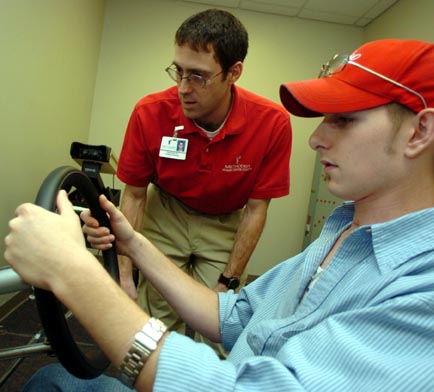FLOWOOD, Miss.—Shawn Ethridge of Collinsville is on the edge of his seat as he eagerly awaits his turn at Methodist Rehabilitation Center’s Driving Rehabilitation Program in Flowood.
Despite having suffered a severe brain injury in a February car crash, the 21-year-old can’t wait to get back behind the wheel. And Methodist occupational therapist Ashlee Ricotta says that’s a fairly common attitude among people who’ve been put in the passenger seat by a disabling injury or illness.
“Driving is what people feel like is their highest freedom,” she says. “When they can drive again, they have their independence back.”
Methodist’s program plays a role in that emancipation by providing driving evaluations and training for people with disabling conditions such as brain injury, stroke, quadriplegia, paraplegia, spina bifada, dementia, epilepsy and brain tumors. The evaluation consists of a comprehensive evaluation of cognition, perception and motor response, as well as an in-vehicle assessment in various traffic situations.
As one of only three such facilities in the state, “we stay booked,” Ricotta said. “We do about four or five evaluations or trainings a week.”
The evaluation begins with a thorough examination of the abilities that affect driving skills. For example, Ethridge’s upper body strength and range of motion were tested to determine his steering ability. Next came a series of tests to determine vision and judgment.
“One area that’s real important is depth awareness,” Ricotta said. “It’s amazing how many people will go into the middle of an intersection because they can’t determine how close the light is. We also look at their peripheral vision. We want to know if there is a spot in their field of view that they can’t see.”
Ethridge also underwent a test for visual memory (the ability to recall street signs and remember where you’re going) and divided attention (the ability to pay attention to more than one thing when you’re out on the road).
The evaluation also includes a test to judge a person’s reaction time when braking or accelerating. “We have norms to compare their reaction time to based on age and gender,” Ricotta said. “That gives us an idea of how they move from accelerator to brake out on the road.”
Ethridge was able to pass his driving test without the addition of adaptive equipment. But for those who need aids such as hand controls or left-foot accelerators, staff at the Methodist can recommend equipment and offer training on how to use it.
“There’s always new equipment coming out and we go to a national conference each year to stay up to date on what’s available,” Ricotta said. “One of the latest things I have seen is a spinner knob for the steering wheel that has switches that can control windshield wipers, air conditioning and sometimes even the radio and cruise control. It allows the driver not to take his hand off the wheel quite as much.”
Ethridge, who sustained a brain injury after being tossed through the rear window of his Honda Accord, said he was eager to pass his evaluation because it meant he was one step closer to getting back to work.
“Driving is what I do for a living, so I really need it.”
Like Ethridge, most people come to driving evaluation eager to reclaim the autonomy that driving affords. Helping them succeed makes her job especially rewarding, Ricotta said.
“Telling them, yes, you can drive—that’s a good feeling. They have their independence back and you can almost see it in their faces. I’ve had people who never smiled a day in therapy and they get their license back and it’s non-stop smiling. You would not believe the amount of hugs I get.”

